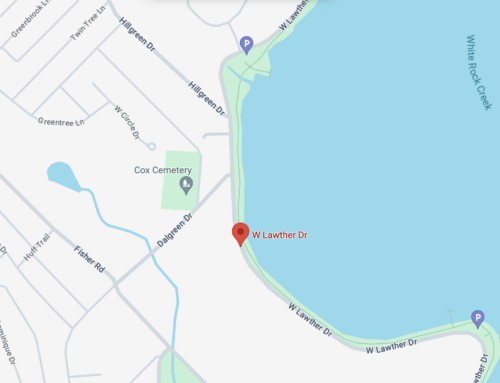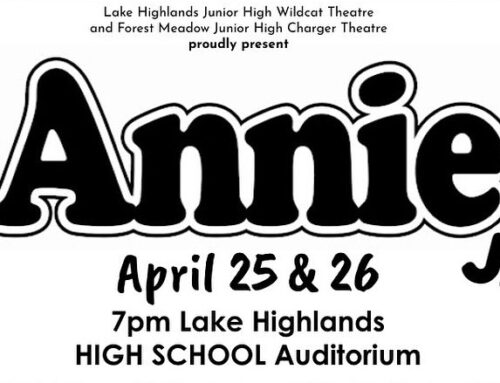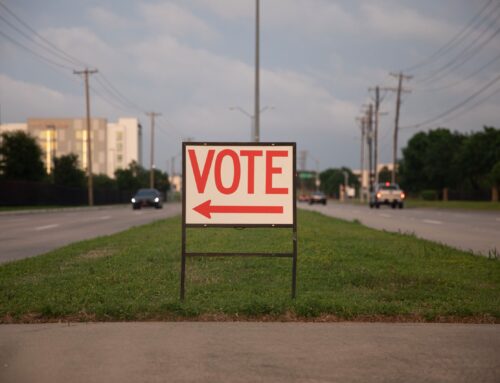At first glance, there doesn’t seem to be anything special about the empty field on the southwest corner of Skillman and Church. One part wraps behind Fields Cemetery until it eventually runs up against a church a couple of blocks south on Skillman. Another portion goes west along Church where it, too, backs up against a church. It’s a little more than eight acres of grass and a stand of stunted trees that have been vacant for what seems like decades.
But this is more than an empty field. To some in Lake Highlands, it’s the future of the neighborhood – the proposed site of a progressive, much needed development in the spirit of the Lake Highlands Town Center. To others, it’s a future that they have already seen and don’t want to repeat – a multi-family project in a residential neighborhood, with all of the history that that entails.
“Yes, we have gotten along for a long time,” says Bill Vandivort, a neighborhood resident and former chairman of the county real estate appraisal board.
“But for 15 or 20 years, the only thing that happened here was that a few empty lots were planted. Now it’s our turn to discover that people have different opinions.”
Since plans for the Town Center were finalized, three major projects have been announced. Their reception has been, at best, lukewarm, and the Church and Skillman proposal hasn’t even been that well received.
Why is a neighborhood that once embraced development – practically begged for it – so divided now that it has arrived?
Why are some so adamant that, save for the Town Center, the only development they want are traditional, single-family homes and traditional neighborhood retail to go with it?
Why do others, equally adamant, insist that this approach is impractical?
And why are personalities usually absent from Lake Highlands political discussions showing up in these debates?
The answer lies in the tangled 20-year relationship between the area and its aging apartment buildings as well as the changing economics of the development business, which focuses on density to the exclusion of almost all else.
And density, to Lake Highlands residents, means apartments.
A SUBURBAN ENVIRONMENT
There are two things that everyone agrees on about Lake Highlands. It’s a wonderful place to live, with good schools and a great location. And it would be even better if The Apartments were gone.
And after 20 years, this finally seems possible. Construction for the Town Center tore a swath through the Skillman area, and more projects are possible – not only along Skillman, as projects piggyback on the Town Center, but in other parts of the neighborhood. In fact, talk to real estate experts and developers, and they’ll tell you that almost any aging apartment building in Lake Highlands is a candidate for re-development.
That’s because developers want land inside LBJ – because people want to live inside LBJ in a way they didn’t 15 or 20 years ago, says Mike Cothern, a neighborhood resident who is a vice president with Revere Commercial Realty.
People want to be closer to their jobs and to urban amenities, and they don’t want long and increasingly costly commutes. It’s a trend that explains the success of the West Village and Mockingbird Station, two decidedly un-Dallas-like projects that have earned international acclaim.
And, says Cothern, the last pieces of affordable, decent-sized parcels of land inside LBJ are in Lake Highlands. It has finally become financially feasible for developers to buy the apartments and tear them down, something that wasn’t possible 10 years ago when there was abundant and affordable land in Uptown or East Dallas.
“For years and years, the idea of Lake Highlands has fallen on deaf ears,” says Chuck Dannis, a neighborhood resident who runs Crosson Dannis, a real estate appraisal and consulting firm. “Now, it’s like developers are saying ‘I get it!’”
So far, so good.
Where the arguments start – and they have sometimes been nasty, personal arguments, played out in public meetings, in e-mails and phone calls, and in blogs and on the internet – is in deciding what replaces the apartments.
City Councilman Jerry Allen, who has aggressively courted developers, has been called anti-neighborhood and a whole lot worse. Neighborhood resident Peggy Hill, whom Allen did not reappoint to the City Plan Commission last spring and who has criticized many of his actions, has been called anti-development.
A variety of points have been made on either side, calling into question the developers, the people supporting the development, the people opposing the development, everyone’s motives, and just exactly what the new development entails. Of special concern has been the height and density of the projects, whether a zoning change is needed to build it, and what kind of zoning change is needed. In short, the community has split into two parts.
One side seems centered around Hill and several neighborhood groups, which want to replace the apartments with what has always been here – traditional, single-family homes, plus a smattering of neighborhood retail to complement the Town Center and its office, retail, multi-family, and townhome and condominium construction. They aren’t against development, they say, but are against the sort of unthinking, development-for-development’s-sake that pushed Lake Highlands into so much trouble 20 years ago.
Says Trey Randal, president of the Merriman Park North Neighborhood Association, which opposes the Skillman/Church project: “We need balance, and if you look at some of what has been proposed, I don’t know where the balance comes from.”
The other side, centered around Allen and much of the area’s political and real estate establishment, sees that approach as outdated. Allen argues that developers, even though they can see the advantage of Lake Highlands, still need to be recruited in much the same way college coaches recruit high school athletes. In addition, developers need density to make money to finance their projects, and density means multi-family – whether it’s upscale apartments or senior citizen housing.
The city’s office of development supports Allen’s claims. Director Theresa O’Donnell says that many of the multi-family apartments the neighborhood is desperate to get rid of were built in the late 1960s and ’70s, when the land cost was low. Those units have become “cash cows” for the owners, even with high vacancy rates.
“There’s not a high incentive to sell that property, and they can demand a pretty high price for the property,” O’Donnell says.
That’s why single-family homes and even new, two-story apartment complexes aren’t feasible replacements, she says, because the numbers have to work for developers. If they don’t have the financial incentive to sell, O’Donnell says, “those multi-family properties will continue to go downhill; the social and criminal problems associated with them will continue to exacerbate; and the ripple effect into the neighborhood will continue to spread. So it’s absolutely necessary that we address those aging multi-family and community strip centers.
“I know there’s opposition to increased density, but the alternative is worse.”
Lake Highlanders are used to single-family meaning “one house on one lot in a traditional neighborhood,” O’Donnell says, and multi-family meaning aging apartment complexes, but both definitions need to be broadened.
Says Cothern: “If single-family comes, it’s not going to be traditional Cambridge homes with a circular driveway and a back yard. It’s going to be zero lot homes. Developers have to get as much value as they can, and that means going vertically.”
PROJECT BY PROJECT
Case in point is the Skillman/Church proposal. Though there has been objection to the other two deals, the objections haven’t been as vehement or as divisive. One project, with plans to turn empty apartment buildings on Northwest Highway just east of Ferndale (the Northwest Terrace project) into private, senior citizen housing, has been approved. The L Streets Neighborhood Association, which includes Northwest Terrace, supported that proposal.
The second project, with plans to build an apartment block of up to seven stories at Shoreview and Ferndale in a mostly empty strip center, initially elicited support from surrounding homeowners, but other neighbors have begun to organize opposition.
At Skillman and Church, however, there is no apparent middle ground. Developer Jonathan Perlman wants a zoning change from single family to planned development to build private senior citizen housing, including a five-story facility. Several neighborhood groups surrounding the site say no: No to the project, no to the zoning change, and no to anyone who supports it.
“We have a real need for single-family homes, and the property is zoned single-family,” says Glee Huebner, co-president of the Highlands West Neighborhood Association, which borders the project. “So why would we want to change the zoning from single-family?”
Because, Allen says, those are the facts of development life.
“I have not done a good enough job of explaining the realities,” he says. “The truth of the matter is that there are others competing for development money, and they’re further out and they have 660 acres for projects versus the four, six, eight acres for projects that we have here.”
The first group, he says, is almost always more attractive to developers, so “you have to build relationships with developers, so they will at least come and look at you.”
The two sides agree on very little. In this, they foreshadow what might happen on future neighborhood development projects unless a compromise is reached:
- The homeowners groups say builders are willing to put single-family on that site, and at least one – Mark Dann of Highland Classic Homes – says that is entirely possible. On the other hand, several who favor the project note that the land has been vacant for a long time.
“To assume that something that has been zoned single-family for at least 40 years and has not been developed in all that time is now going to be developed? That’s a difficult thing to sell,”
says former City Councilwoman Donna Halstead.
- The pro-project side points to the District 10 Strategic Plan, a zoning blueprint for the area approved in 2006 that calls for increased density along Skillman. The homeowners, say their leaders, don’t agree with that part of the plan.
- The homeowners say they want more community meetings with developers and a more open approach to the planning process. “This is our community,” Randal says, “not the developer’s community. We need to do more to let us have a say.” In this, he points to Prescott Realty and the town meeting process it used to keep Lake Highlands informed while it put the Town Center project together.
HOW REALISTIC IS REALISTIC?
Can someone, somehow, find a middle ground that will allow some kind of development at Skillman and Church – and, by extension, find a middle ground for the development that is almost surely to come elsewhere in Lake Highlands?
It won’t be easy. Hill, who despite rumors in the neighborhood says she has no plans to run for the City Council next May when Allen is up for re-election, doesn’t leave much room for compromise.
“This is the greediest overkill development I have ever seen,” she says. “You don’t see four stories in Lakewood or Preston Hollow or the Park Cities. If this was anywhere else, it would be unheard of.”
Also complicating any compromise: Many on the pro-density side see resistance to development as not necessarily widespread, but focused in a very vocal minority. Some are convinced that most residents are in favor of this development, but they’re just too busy or too unconcerned to make their feelings known.
“Frankly, this boggles my mind,” says Cothern, who works in the community leasing retail space. “I want to go, ‘Hey, people, we’ve been waiting for this. We need it. It will send our property values up.’”
In the end, everyone may end up giving a little – even if they don’t want to.
Jimmy Christon’s company redid the Northlake Shopping Center at Ferndale and Northwest Highway several years ago and developed the Wal-Mart at Abrams and Forest, the only two major projects in the area in the decade before the Town Center. He has lived in Lake Highlands, and his sons live here now. In all of this, he sees both sides.
“Are the residents’ expectations too high? Yes,” Christon says. “If you talk to them, they want things that aren’t going to happen. When we put in Wal-Mart, they wanted Neiman Marcus, and that wasn’t going to happen.
“When you did a center in the old days, you always knew what you were going to get – a Hallmark store, a local dress shop, a local jewelry store.
“That’s not the case anymore. You’re not going to get anything that’s at NorthPark. Why, if I have a store at NorthPark, am I going to open in Lake Highlands?”
Yet, he says, many of the divisions in the neighborhood can be solved by better communication, be it developers doing more to include residents in the planning process or neighborhood leaders taking a more active role in educating the community.
When that doesn’t happen, he says, residents get their feelings hurt. And our neighborhood already is experiencing what happens then.





